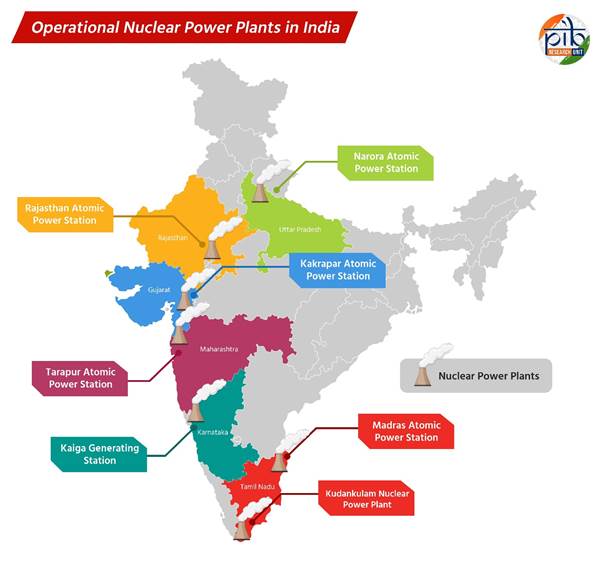Others
RAPP-7 Achieves Criticality: A New Era for India’s Nuclear Energy
Paving the way for 500 GW of non-fossil fuel energy
Posted On: 28 SEP 2024 7:06PM
Introduction
In the quiet heart of Rajasthan, beneath the vast skies of Rawatbhata, a new chapter in India's nuclear journey unfolded. On the evening of September 19, 2024, at 9:42 PM, the Rajasthan Atomic Power Project's Unit-7 (RAPP-7), one of the country’s largest nuclear reactors, quietly reached a milestone known as criticality. This moment, often unnoticed by the world outside, marked the beginning of controlled fission, the very process that fuels the generation of nuclear energy.
This is not just another step in India’s energy plan; it is part of a broader story where nuclear power is poised to light up homes and industries with clean, reliable energy. With RAPP-7, India's third indigenous reactor of its kind, now crossing this key threshold, the project transitions from construction to operation. This signals the onset of a phase in which tests will refine and perfect its power generation before it connects to the national grid.
At its core, this event highlights India’s growing capability in building and operating its own nuclear reactors, paving the way for a future powered by homegrown technology. For Rawatbhata and the nation, the countdown to a brighter tomorrow has begun.

Criticality: The Heartbeat of a Nuclear Reactor
Criticality in a nuclear reactor marks the moment when a steady and controlled chain reaction of nuclear fission begins. This means the reactor reaches a balance where the neutrons created by the fission process match the number lost, either through absorption or escape. At this point, the reactor can maintain a stable power output.
The Atomic Energy Regulatory Board (AERB), India’s nuclear safety regulator, granted permission to initiate a controlled nuclear fission reaction in the Rajasthan Atomic Power Project (RAPP) Unit-7 on September 10, 2024. The AERB's authorization covered the addition of heavy water to the reactor’s moderator system and the initiation of the First Approach to Criticality, which involves controlled nuclear fission. It also included the conduct of low power physics experiments. This decision was made after comprehensive assessments of the reactor’s design, construction, and operational preparedness.

Reaching criticality is a key step in the life of the reactor, as it signals the shift from building the reactor to running it. Once criticality is achieved, the reactor starts producing heat, which is later turned into electricity. Managing this process with care is crucial, as it ensures the reactor runs safely within its designed limits.
RAPP-7 & India's Nuclear Landscape
RAPP-7, located in Rawatbhata, Rajasthan, is a 700 MW Pressurized Heavy Water Reactor (PHWR). It is the third in a series of sixteen reactors being built in India, showing the country's growing skill in nuclear power. The project is owned and run by the Nuclear Power Corporation of India Limited (NPCIL), and plays a key part in ensuring India’s energy needs are met.
Following the success of similar units at the Kakrapar Atomic Power Station in Gujarat, RAPP-7 builds on the proven strength of India’s homegrown nuclear technology. This project, alongside RAPP-8, which will begin operating next year, has a total planned power capacity of 1400 MW. Together with the six other units already running at Rawatbhata, these reactors add significant power to the grid.

NPCIL currently operates 24 reactors across 7 power plants with a total capacity of 8180 MW. In addition to RAPP-7, eight more reactors are being built, adding another 6800 MW of power in the near future. Looking further ahead, ten more reactors are in the early planning stages, with a goal to complete them by 2031-32, further boosting India’s energy supply.
Empowering Clean Energy
India’s nuclear energy program is a vital part of its plan to create a low-carbon economy. With a target of reaching 500 gigawatts of non-fossil fuel energy by 2030, nuclear power stands out as a dependable and scalable solution. As a zero-emission source of energy, nuclear power helps lessen the country’s dependence on coal and other fossil fuels. The achievement of criticality at RAPP Unit-7 is an important step toward reaching these energy and environmental goals.

The Department of Atomic Energy (DAE) and the Nuclear Power Corporation of India Limited (NPCIL) have worked tirelessly to ensure the project progresses on schedule. With this milestone, India takes another significant leap forward in boosting its domestic power generation while also reducing its carbon footprint.
Conclusion
The achievement of criticality at RAPP-7 is a landmark moment in India’s journey toward energy independence and sustainability. This milestone not only showcases the nation’s growing expertise in nuclear technology but also reinforces its commitment to a cleaner and greener future. As RAPP-7 prepares to generate power, it symbolizes hope for countless households and industries that will benefit from reliable and clean energy. With ongoing efforts to expand nuclear capabilities and reduce carbon emissions, India is well on its way to achieving its ambitious energy targets. The path ahead is bright, and with each step taken, India moves closer to a more sustainable and self-reliant energy landscape.
References:
Kindly find the pdf file
*****
Santosh Kumar/ Sarla Meena/ Ishita Biswas/ Saurabh Kalia
(Backgrounder ID: 153218)
Visitor Counter : 3111